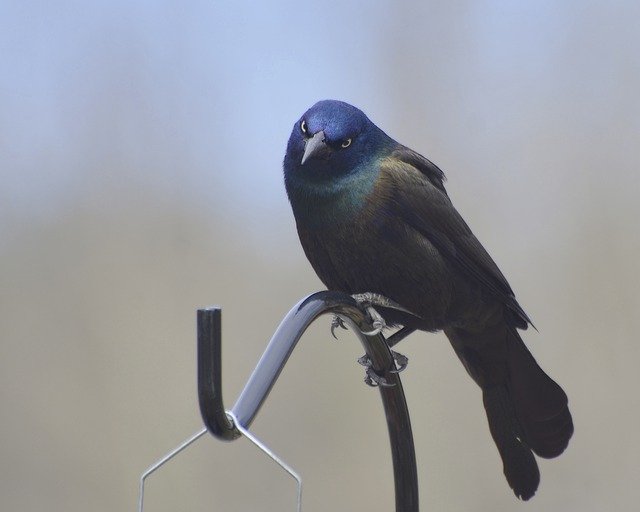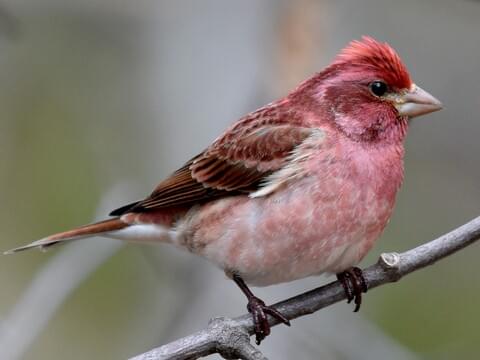Georgia is home to its fair share of exotic birds from the boring and bland gray colored ones to the more outlandish and out there purple colored ones. In this article I’ll be going over 5 unique purple birds that are found in Georgia anf consider the state as home.
- Purple Martin
- Common Grackle
- Purple Finch
- Rock Pigeon
- Purple Gallinule
5 Purple Birds In Georgia
1. Purple Martin (Progne Subis)

- Size: 19 – 20cm
- Weight: 45 – 60 grams
- Wingspan: 39 – 41cm
You’ll be able to spot purple martins in Georgia when they happen to be breeding. This generally would encompass the summer and spring months.
Purple Martins are recognised by their almost entirely purple plumage with the wings and lower half of their body purple, and the remainder a darker blue color. Females on the hand are mostly white and gray with hints of blue on their plumage.
As for where these birds live, it tends to be around open locations that are at least 40 ft. from trees or buildings so, you’ll often see them perching on utility wires and houses throughout the local Texan neighbourhood.
Purple Martins tend to eat mostly flying insects like house flies, crane flies, beetles, moths, butterflies and even dragonflies. Dragonflies in particular are a very important part of their diet.
These avians have been known to live for 13 years but, the average for most probably wouldn’t surpass 6 – 7 years.
2. Common Grackle (Quiscalus Quiscula)

- Size: 28 – 34cm
- Weight: 74 – 142 grams
- Wingspan: 36 – 46cm
Common grackles consider Georgia their home throughout the year as it’s a year round residence of theirs.
The common grackle is recognised by their purple head, brown mixed with hints of purple on their wings and back, blue wing tail and chest. Females are mostly a duller darker brown color with small inklings of purple on their body.
These birds tend to spend the majority of their time within wet, open woodlands, marshes as well as in suburbs, parks, and agricultural fields.
As for the type of food a common grackle eats, it includes eating many forms of crops like corn as well as nearly anything else that catches their eyes such as food foraged from garbage.
The average lifespan for these birds is around 17 years whilst some are able to live till the age of 22.
3. Purple Finch (Haemorhous Purpureus)

- Size: 15 – 16cm
- Weight: 24 – 26 grams
- Wingspan: 25 – 26cm
Purple finches can be found all throughout Georgia in their non breeding months. This would generally include the fall and winter months.
Purple finches are recognised by their pinkish plumage with hints of purple throughout, their mohawk like head feathers and gray beak. Females on the other hand are mostly brown with the brown color patterned throughout.
These finches can be found in coniferous and mixed woods, both in forest interior and along edges. They also tend to breed near oak trees and streamsides.
Purple finches tend to eat a variety foods from insects, small fruits, berries and seeds, with seeds being their go to food source.
The average lifespan for these birds is around 3 – 4 years though many are also able to live till 6 or 7 years of age.
4. Rock Pigeon (Columba Livia)

- Size: 30 – 36cm
- Weight: 265 – 380 grams
- Wingspan: 50 – 67cm
These rock pigeons can be found all throughout Georgia year round as it is a permanent residence of theirs.
Rock pigeons are mostly gray with elements of black on their wings and green plus purple hue across their neck. Females are generally smaller in size and also have a flatter head unlike the males who tend to have a more round head shape.
These pigeons spend the majority of their time around urban parks and neighbourhoods, around farms, under highway, railroad bridges as well as near tall rocky cliffs.
In regards to the food rock pigeons eat, they include a variety of seeds, bread crumbs, seed grasses, worms among other insects, berries and acorns.
Rock pigeons tend to live for 6 years in the wild when averaged out.
5. Purple Gallinule (Porphyrio Martinicus)

- Size: 33 – 37cm
- Weight: 203 – 291 grams
- Wingspan: 55 – 56cm
American purple gallinules can be found in southern and central Georgia when they are breeding.
Purple gallinules are recognised by their purple neck and chest, their green wings, their dirty yellow colored back, yellow legs and striking red beak. Females on the other hand are a dull brown color.
These purple birds tend to inhabit mostly freshwater marshes that hold water year-round and have sedges, grasses or rushes. Purple gallinules especially prefer areas with dense stands of emergent floating vegetation like the American lotus, water shield, spatterdock, pickerel weed, arrowhead, water pennywort, etc.
As for what their diet consists of, it includes feeding on spiders, mollusks, beetles, bees, worms, snails, dragonflies, leeches, moth larvae as well as frogs, small fish, eggs and nestlings of other birds.
Purple gallinules are known to live for around 22 years in most cases but, some have lived upwards of 25 years old.
Related
If you want to find out about red birds in Georgia Click Here
If you want to find out about yellow birds in Georgia Click Here
If you want to find out about orange in Georgia Click Here
If you want to find out about big birds in Georgia Click Here
If you want to find out about green birds in Georgia Click Here
If you to find our about white birds in Georgia Click Here
Amhil Khan, a dedicated nature enthusiast and the founder of BirdsOfTheWild.com, is a passionate advocate for the captivating world of avian wonders. With a deep-seated curiosity about the intricate lives of birds, Amhil’s journey began as a fascination and has evolved into a mission to inspire others to appreciate and protect these magnificent creatures.
Amhil’s love for birds led to the creation of Birds of the Wild, a platform where his expertise in ornithology, coupled with his captivating storytelling, provides readers with an immersive and educational experience. Through his lens and words, he captures the essence of birds in their natural habitats, offering a glimpse into their behaviors, migrations, and the ecosystems they inhabit.

